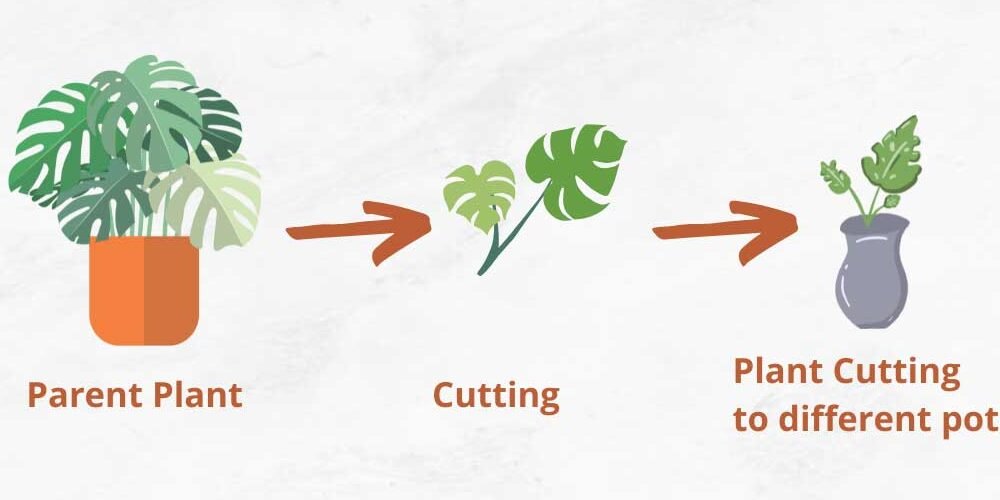How to Propagate Mini Monstera and its Care
Adding vines like Mini Monstera brings mobility and greenery to stagnant homes. To make this foliage beauty a part of your life, know how to propagate Mini Monstera.
Mini Monstera or Monstera minima is an elegant vibe-like plant that grows only up to fifteen centimetres. Like other Monstera, requires vast care as these are sensitive to environmental or soil quality fluctuations. Rhaphidophora Tetrasperma may look like Monstera Deliciosa, but in terms of care, it holds a huge advantage over M. Deliciosa. As said, the smaller the plant, the minimal its needs.
The split pattern and fenestrations in its leaves are architecturally interesting and create a unique impact when viewed in harmony with its surroundings. The split pattern may have been the main reason for people adopting this plant in the first place, but it was one of the adaptability mechanisms that allowed coastal winds to pass through it, without harming its foliage and structure. The split lobes measure around 5-6 inches in width when it starts climbing.
Monstera Minima have aerial roots, so it could easily be used as a vine with the help of trellis, as well as for hanging basket purposes, or it could be styled in a manner to make it look bushy. People who want to introduce unique varieties of plants, but lack spaces in their homes, especially in Urban areas, must know about this stunning plant.

| Common Name | Mini Monstera, Monstera minima, Ginny Philodendron |
| Botanical Name | Rhaphidophora tetrasperma |
| Family | Araceae |
| Origin | Southern Thailand and Malaysia |
| Height | Upto 12 feet tall and 1-4 feet wide |
| Plant Type | Perennial |
| Flowering | Summer/Spring, fertilisation requires a ratio of 3-1-2 monthly |
| Hardiness Zone | 9-12(USDA) |
| Chromosome Number | 2n =60 |
How to Propagate Mini Monstera : Physical and Nutritional Factors
Light
Bright and indirect sunlight is best for the healthy growth of Mini Monstera. On the other hand, it may not survive in complete shade. It could be grown indoors along the east or south-facing windows and avoid its direct exposure to evening sunlight as it may cause sunburn. If the house doesn’t have enough sunlight then an LED light or fluorescent may work. Leaves without fenestrations are a peculiar symptom that the plant needs more water.
Temperature
It thrives best in a temperature range between 60-80°F(night temperature above 60°F). A cold and dry environment kills the plant. Avoid positioning it near the air conditions or in cooler areas.
Humidity
Mini Monstera prefers humidity between 40-60%. To maintain humidity around the pot, add a pebble tray or humidifier and never use hard or soft water for it. Spritzing leaves from time to time also helps in maintaining humidity.
Soil
A well-drained and slightly acidic(pH 5-6.5) mixture is preferred for its healthy growth. Instead of using raw soil, use a mixture of perlite, coco peat and moss, which will not only allow good drainage but also be lightweight in the pot.
Water
Avoid overwatering and waterlogging conditions around Mini Monstera, as it causes severe root rot and ultimately death of the plant. Water it when it shows symptoms of waterless deficiency or when a few inches of topsoil becomes completely dry. That’s why, always use pots with good drainage properties.
Fertilizer
A diluted liquid fertilizer once a month in spring and summer will help the plant in its vigorous growth. However, always use half the recommended dose of fertilizer if you are growing it for indoor purposes. Slow growth is preferred in indoor conditions. One must not apply fertilizer in winter and autumn, as it will not have any effect on plant growth, hence, that time of the year is a resting period for the plant.
Pruning in Mini Monstera
Pruning is not necessary in Mini Monstera. It is done only when the gardener or owner wants to restrict its growth due to lack of space and just to style it for different purposes. Sometimes pruning is needed to remove dead parts or disease-infected parts of the plant.
Method of Propagation in Mini Monstera
The best-known propagating method in Mini Monstera is by Stem Cutting. It rarely flowers and has aerial roots with vining properties since it is hard to propagate by any other means. Stem cuttings should always be obtained from mature plants, it also reshapes the older plant. Follow these steps to successfully propagate Mini Monstera.
- Use a sharp knife to cut the stems from a mature plant that has at least three nodes. Always use gloves while cutting or pruning this plant as the toxins of this plant can cause serious irritation around your mouth.
- Remove the leaves up to one to two nodes and dip the cuttings in water in a glass vase or transparent container, so they could receive ample amount of sunlight.
- Carefully place the container in a place that receives bright indirect sunlight. One can add growing media(IBA solution)in the water for early root initiation. Change the water every once or twice a week to prevent algal growth.
- When the root initiates up to two to three inches, the cuttings could be replaced from water to soil mixture.
- Keep the soil mixture consistently moist but avoid overwatering.

The Mini Monstera can also be kept in the water solution forever in indoor conditions, but its growth won’t be as rigorous as it will be in a soil mixture.

Potting and Repotting in Mini Monstera
Mini monstera can be grown with support like a moss stand or wood piece. It will encourage the upward climbing of plants and lead to more efficient growth. It should be repotted only when it starts outgrowing its original pot or container. Repot only in spring or early summer because that’s when the plant growth is active. It might need to be repotted every two years.
For Repotting, follow the following steps:-
- Water the old plant before removing the plant.
- Remove the plant carefully along with the root ball.
- Trim out the rotten or dead roots with the help of a disinfected sharp knife.
- Place the plant in a two-inch larger container with a well-prepared soil mixture, about one or two inches below the edge.
- Water the plant and ensure that the water is drained properly. And continue to provide them with appropriate sunlight.
Types of Mini Monstera
Rhaphidophora tetrasperma
‘Variegata’ It is a variegated variety with serrated leaves. Variegated Monsteras are always higher in cost than the other ones.

Rhaphidophora pertusa
This is the most classic kind of Mini Monstera with dark green foliage and fenestrations.

Rhaphidophora korthalsii
It has heart-shaped leaves and less recognizable fenestration. It is lushier than other varieties. These features don’t make it a good resemblance to Mini Monstera.

Problems while Propagating Mini Monstera
Toxicity
Consumption of its leaves is very toxic to pets and children, its toxin, calcium oxalate crystals can cause severe allergies and irritation in humans including vomiting and a burning sensation around the mouth.
Insects
Insects like spider mites or scales are most prominent in monstera when grown as a houseplant. A small application of Insecticides like Cypermethrin or Acetamiprid can help in the control of these insects. Although these insects don’t cause much damage to the plant.

Diseases
Root rot diseases caused by soil-borne fungi such as Fusarium can be observed in the mini monstera after its exposure to prolonged waterlogged conditions. It leads to rooting of the root system and the plant dries off completely. It can be prevented by repotting with the removal of diseased roots and the application of 0.2% carbendazim or Bordeaux Mixture.

Curled Drooping Leaves
It occurs when the plant has been dried out for a long time. Apply water in prescribed intervals, but if there is no improvement, it might be possible that the plant is already dead and can’t be re-established.

Benefits of Propagating Mini Monstera
- It acts as an Air Purifier.Mini Monstera could be used as a desk plant that will raise the aesthetic value of the workplace and home.
- If added alongside other plants, it will improve the overall view of the garden.
- Its uniqueness can attract customers, other gardeners and relatives.
- The propagation practice and care help in stress reduction and improve health.
- It can also be used as a curtain plant to hide the rear side of the garden or house.
- It lies along with the feng shui principles and shows sound absorption capabilities.
Market Value of Mini Monstera
Recently Mini Monstera has gained a lot of popularity which leads to a rise in its demand in the market and due to its accommodation in a wide range of temperatures, it is being cultivated globally. Though the price of its cuttings is quite average, once a rare yellow variegated species of this plant was valued at $8150 in bidding. Similarly, a rare white one was auctioned in New Zealand for $19,300(US). This means any variegated varieties of this plant hold high economic value.
Also Read:
Conclusion
Adding plants indoors may look like a luxury and it is easier to just buy a new plant from the market to add more plants every now and then. However, propagating a new plant from older plants is a whole new learning that requires patience and time. Propagation may not succeed in the first go but don’t dishearten yourself, keep trying and learn about the causes of failure, and improve.
If you are new to propagation, don’t worry, just give it a try. You will eventually end up learning something new, in the same way as we learned about variegated varieties of mini Monstera, which now holds great value among gardeners. It may look like a tedious task at first, but in gardening, the more effort you put into it, the more beautiful results you will earn.
In this article, we have covered all the aspects of ‘How to Propagate Mini Monstera’, its care and needs. Now you can calculate the amount of effort and time that will be required by this plant to be propagated under your gaze.
FAQs
Is Mini Monstera and Monstera the same plant?
No, Mini Monstera may look like a miniature of Monstera and they both belong to the same family, but these two are different species with Mini Monstera showing vining properties, unlike your regular Monstera. And you can’t put your biggie Monsteras on your working desk like mini Monsteras.
Is it rare to grow Montera in your house?
No, and sometimes Yes. With its increasing popularity and wider adaptability, people around the world have been adopting it on a large scale. But in a few places, monstera is not a daily household plant.

